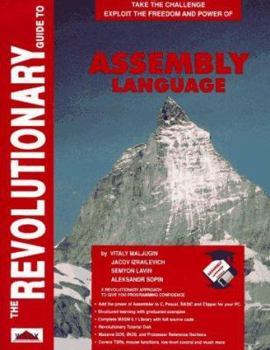Revolutionary Guide to Assemb Ly Language
Select Format
Select Condition 
Book Overview
Learn how to design, develop and debug powerful assembly language routines, and take control of your systems and increase the power of your high-level programs. Paper. 3 1/2 inch disk included. This description may be from another edition of this product.
Format:Paperback
Language:English
ISBN:1874416125
ISBN13:9781874416128
Release Date:January 1993
Publisher:Wrox Press
Length:986 Pages
Weight:3.75 lbs.
Dimensions:2.2" x 7.2" x 9.2"
Customer Reviews
5 ratings
Good intermediate book!
Published by Thriftbooks.com User , 22 years ago
If you know some high level language (concepts, structure, procedures, functions) and have a basis in assembler (know what mov means) Then this book can be of value. Has a lot of good examples for each subject covered. Covers a subject that I don't see covered much in alot of the assembler books I have read, writing macros (like writing a function in a high level language, sort of). I would recommend these books in order: ASSEMBLY LANGUAGE STEP BY STEP, REVOLUTIONARY GUIDE TO ASSEMBLY LANGUAGE, MASTER CLASS-ASSEMBLY LANGUAGE.
GREAT Book!
Published by Thriftbooks.com User , 23 years ago
If I had to rate this book in 2 words it would simply be "BUY NOW!" This book teachers everything that you need to be an intermediate programmer (unfortuanately the interrupts are only for DOS not linux or unix or mac or so on) but it is a great book. Comes with complete source code but no compiler.
GOOD IF YOU ALREADY KNOW A LITTLE ABOUT ASSEMBLY
Published by Thriftbooks.com User , 23 years ago
I've been programming in assembly language (among other languages) since 1980, but just recently I decided I needed a book to brush up on some of the aspects of programming in assembly language on the 80x86 chip set. I bought this book because I felt like out of the books I reviewed, it was the easiest to read and the most well laid out in general. It also was very complete.The book covers most aspects of assembly language and how it can be used on the IBM PC and compatible computers. It details system (BIOS) calls available on the PC to the assembly language programmer and gives you a good working knowledge of what you are up against when programming in assembly language. However, as the author states up front, this book does not cover a few of the more advanced features of assembly language on the PC (protected memory modes, 32 bit instructions, etc). With that said, I don't think this should really be viewed as much of a short coming. In many cases, these commands aren't often used anyway and certainly their absence in this text doesn't detract from what this books sets out to teach you.The book (and one of the main reasons I bought it) also has a very nicely laid out reference section that clearly explains each instruction (aka the commands) available to the programmer in the Intel chip set.However, as good as this book is for someone wanting to get up to speed on assembly language, I would caution prospective buyers against assuming this is a book designed for the "total novice" when it comes to assembly language programming. Even if you already know how to program in a language such as Basic or Perl, programming in assembly language can sometimes be quite a change of gears in thinking. There are no "Print" commands in assembly language :-) There are macro functions in MASM 6, but at the same time when you program in assembly language, you largely are dealing directly with memory locations, registers and the core instruction set in the CPU. You have to think in terms of binary numbers, and raw data to a large degree. All that is fine if you already have a broad understanding of what's going on in assembly language to begin with. However, if you don't (i.e. if you are a total novice to the world of assembly language programming), then there is a chance this book may leave you a little confused at the start. When I first taught myself how to program in assembly language, it was at the age of about 15. At that time, I had no concept of what binary was, nor did I have any idea how memory locations, let alone how registers of a CPU fit into the big picture. Fortunately, the book I used to teach myself started from square one and assumed you knew nothing about binary or anything else. While those chapters were very hard to get a handle on initially, looking back they were very important to understanding the overall concept of how assembly language functions. Again, as good as this book is, my fear is that someone starting at squar
excellent......supurb
Published by Thriftbooks.com User , 26 years ago
this is a great book.........a must buy for anyone wishing to learn assembly.......i would suggest that you read Peter Nortans Assembly Language Programming book before this one.........i did that and everything really fit together nicely.....it only took me one month to read both books.....make my own hex editor.......an addictive game.......and many many many useful util's and apps.......i am now entering the exciting realm of 3d games programing with ease.....and believe me i needed assembly......i needed and still need this book.......excellent reference............
Great ASM book! Some high level language experience required
Published by Thriftbooks.com User , 26 years ago
Now this is a VERY good book. It covers all the basics and more. The disk that comes with it is sort of useful at first, but the book itself is the best for all you potential assembly freaks. Trust me on this one, you can't do with out it! I gave it a nine just because there are no perfect books.





